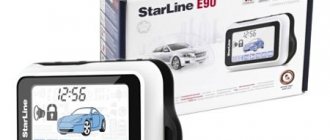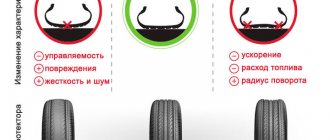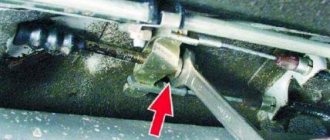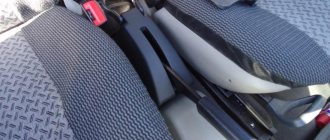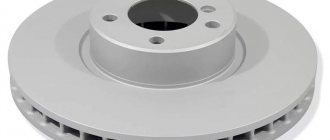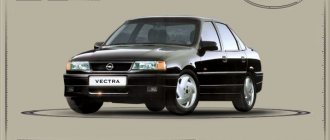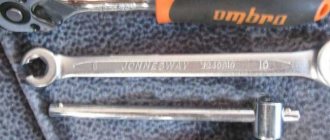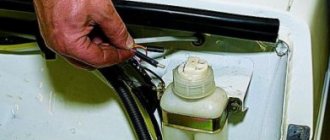Why do brake pads freeze?
With the arrival of frost, ice creates problems not only on the road. When water freezes, it prevents the operation of open vehicle components. This is especially true for the braking system.
Sometimes problems arise with the front brakes, but more often situations occur when the handbrake pads are frozen.
In this case, attempts to move off may result in the friction linings breaking off from the base and instead of a trip you will have to go to a service station. Therefore, you need to know how to unblock frozen pads using improvised means.
After reading the article you will learn:
- Why do brake pads freeze?
- 6 ways to unlock handbrake pads in cold weather
- How to prevent brakes from freezing again?
Car owners have to deal with icy brakes in winter or in the off-season. It is enough to wash the car or just drive through a puddle before parking it so that in the morning the pads will freeze tightly to the brake drum or disc.
This happens if the driver puts the car on the handbrake before the brakes have had time to dry. Sometimes even the front pads freeze, since they are not pressed so tightly against the disc when parked. This happens when there is an abundance of water and there is a small gap between the pads and the disc. But more often the problem is associated with the rear brakes and handbrake. There are several reasons:
- The ice that forms between the lining and the drum sticks the parts together and prevents the wheel from turning.
- Water gets under the handbrake cable sheath and the pads remain fixed after the driver lowers the handbrake lever.
- Ice gets into the brake mechanism and blocks its operation.
You don't have to drive into puddles for the pads to freeze to the discs or drums. Condensation or water formed as a result of melting snow is sufficient.
Front brakes freeze much less often than rear brakes. There are two reasons for this:
- Most of the braking load falls on the front wheels. Therefore, heat is generated there more intensely and the mechanism dries out much faster.
- Drum brakes are often installed on the rear axle. They are more vulnerable to icing due to the closed design of the mechanism and the larger area of the friction linings.
The handbrake freezes only at negative temperatures. In warm weather, similar symptoms may occur if the handbrake cable, brake pads, or cylinder are stuck. In this case, all that remains is to contact a service station or repair the brake system yourself.
The complexity and methods of freeing the brakes from ice captivity depend on two factors:
- System design. Disc brakes are much easier to defrost than drum brakes.
- Location of ice impact. The cable, pads and brake mechanism may freeze. Depending on this, you need to warm up the corresponding components.
The first thing to do is try to carefully move away. If there is not a lot of ice or it has not had time to freeze well, the pads can be torn off without harm to the mechanism.
If the linings are frozen tightly or the handbrake cable is frozen, it will not be possible to solve the problem through the efforts of the engine. A race between the brakes and the engine can cause transmission, hub, or pad failure.
If, when carefully trying to start, the car does not move, you need to melt the ice. There are several ways to do this.
Fill a bucket or at least a kettle of hot water and pour it onto the brake drum. In mild frost, this is enough to melt the ice holding the wheels. This method is especially effective if the rear brakes have an open disc design. Heating with water has disadvantages:
- Moisture floods the pads and mechanism. Therefore, if you do not immediately drive and dry the brakes, they will freeze again.
- In severe frost (above 15 degrees), hot water quickly freezes and may not warm the pads, but may worsen the situation.
Stamped wheels can interfere with heating, so it is better to remove the wheels before surgery. When the ice melts and the drum begins to rotate freely, you need to immediately put the disc in place and go.
The higher the salt content in the water, the lower the freezing point. Therefore, saline solution can dissolve ice. All you need is a pack of salt and a bottle of water. The problem is that, unlike warm water, the solution must get onto the ice, and not just wash the brake drum.
Where can I get warm water?
In an open parking lot it is difficult to find a kettle or stove. However, finding warm water in winter is not so difficult. To do this you need:
- Warm running engine.
- Snow.
- Plastic bottle (preferably several).
Fill a bottle with snow, close it tightly and place it in the cabin near the heater air duct outlet. You can try to heat the water directly from the heat of the engine. However, it is difficult to secure the bottle in the engine compartment. Please note that the plastic may melt if it comes into contact with the exhaust manifold or other part that is too hot.
Windshield wiper fluid does not freeze at low temperatures and can effectively melt ice. To do this, you need to pour it inside the mechanism through the hole in the wheel rim. The ice will melt in 2-3 minutes.
. But pouring anti-freeze into a closed drum so that it gets directly onto the pads is problematic.
Antifreeze liquid reduces friction. Therefore, at the beginning of the trip, you need to wipe off the oily layer by pressing the brakes 5-6 times.
Instead of antifreeze, you can use alcohol or gasoline. They do not create an oily coating, but have a high fire hazard.
WD-40 aerosol, designed to make disassembling threaded connections easier, can also deal with ice.
If there are outlets near the car, you can use a powerful hair dryer. The flow of warm air simultaneously defrosts and dries the pads. Therefore, after completing the procedure, you can simply leave the car in the garage or parking lot. After using a hair dryer, the brakes do not need to be dried.
If you have a gas or liquid fuel heat gun, you can heat the wheels even faster. However, their fans require electricity. Therefore, it will not be possible to get rid of the connection to the outlet.
To create an improvised hair dryer, you will need a large diameter hose. Place it on the exhaust pipe, start the engine and direct the exhaust gases to the brake mechanism. The effectiveness of this method depends on the characteristics of the exhaust system. Hot exhaust gases are typical for older cars with large engine displacement.
Ice is a very fragile material. Therefore, it can be destroyed using shock loads. To do this you need a hammer and a wooden plank. Remove the wheel and tap the brake drum on all sides. The ice will crumble and the brakes will return to normal operation.
If ice has frozen under the braid of the handbrake cable, it is useless to warm or water the brake mechanism. In this case, it is the cable that will have to be warmed up. This can be done with a hairdryer or a heat gun.
It is not difficult to notice that the cable is jammed. Lower and raise the handbrake lever. If it lifts up effortlessly and then suddenly stops, that is the problem, not the pads.
What to do if the handbrake is frozen?
- If the car is “tightly” immobilized by frozen pads, try to move them with the parking brake handle. Press the handbrake two or three times until it stops, then release. If you manage to knock the ice out of the system, the lever will move without resistance. You can continue moving.
This method is quite effective, but there is a danger of damaging the lever or brake pads.
- Melt the ice with regular hot water, but not boiling water (it may crack the brake system elements). After 20–30 seconds, move away. Start moving immediately before the water freezes again.
Use a saturated saline solution as an alternative to water. This measure will release the handbrake and prevent the formation of a new ice crust.
Use special solutions. Products used to de-ice locking mechanisms and glass are ideal. Alternatively, use ethyl alcohol or regular vodka (they have non-freezing properties similar to technical liquids).
To remove severe icing using available chemicals, you may need to remove the rear wheels.
To remove severe icing, you can use hot water, saline solution or chemical compounds.
- Use the heat from the exhaust gases. Take a hose long enough to direct the hot stream from the exhaust pipe to the icy brake pads. The method is effective, but it will take a lot of time to get results.
- Remove ice from the discs using a rubber (wooden) hammer or other similar means at hand. Remove the rear wheels. Tap the brake mechanisms with a hammer.
Quite often the parking brake cable can become frozen. There are two effective options for solving the problem. You can try to heat the cable using improvised means or pour a defrosting agent into its jacket.
Attention! Do not use open fire, homemade torches or blowtorches to warm the brakes. This can lead to destruction of rubber products.
Drying the pads
If you know that your car has a tendency to give you frozen tires or a frozen gas cap, it's best to try to prevent such problems from occurring.
When it is necessary to stand on the handbrake, it is better to perform some manipulations before doing so. Simply pick up speed and press the brake pedal several times. Friction will occur, the element will heat up, and the water will simply evaporate.
Conclusion
While driving, try to reduce the ingress of water. If it is impossible to avoid a puddle, reduce your speed. When preparing your car for winter, do not ignore the brake system. Maintain it thoroughly, lubricate all elements. This measure will not only prevent icing, but also protect parts from corrosion and extend their service life. Remember, the performance of the brakes is a guarantee of the safety of your entire family.
Have you ever had to troubleshoot a freezing handbrake problem? Share your experience with our readers in the comments. Your knowledge will be very useful.
Brake pads are frozen - What to do?
Hi all! Winter is a special period for motorists, when all sorts of unexpected problems arise and the need arises to carry out a number of additional measures. How many of you have encountered a situation where the brake pads suddenly freeze and you can no longer remove it?
I had a similar experience. Therefore, I can share some thoughts and observations on this matter.
From personal experience, as well as based on the recommendations of specialists, I will tell you what to do in such a situation, why a pad may stick to the drum or disk, how to proceed and how to prevent this from happening in the future.
How to avoid freezing
There are three “golden rules”, following which you won’t have to waste time defrosting:
- do not put the car in “handbrake” - only gear (even a short stop can be lethal);
- “dry” the brakes before winter parking, as well as after washing (before stopping, you need to brake 5-6 times so that the moisture trapped between the pads and discs (drum) evaporates);
- drive around puddles, do not “throw” into snowdrifts.
The main rule is to protect the brake mechanism as much as possible from moisture or remove it before ice forms. Don't forget to regularly clean the water drainage holes located on the wheel braking mechanisms with a brush.
Freezing of pads is a common and uncomplicated case, so the first time you encounter such a problem, you should not worry. The simplest and most common means of heating is hot water (although there are more “cunning” methods). For prevention, you need to monitor the width of the gap between the pad and the disc (drum), as well as the wheel brake mechanism in general: the more serviceable they are, the fewer problems, and not only with freezing.
Handbrake brake pads are an integral part of any vehicle, since such a product provides maximum safety when parking the vehicle. Situations often occur when, in winter, vehicle owners are faced with the fact that the hand (parking) brake freezes, resulting in complex problems. They can easily be solved by the car owner himself, or by a competent expert from service centers.
Design features of handbrake brake pads
Every experienced car owner knows that these components can be made from the following materials:
- Organic is the best solution. Such components have only one drawback. It is caused by insufficient braking during periods of abundant moisture. However, when the vehicle is parked, this aspect is not important.
- Semi-metallic pads. They are made from soft steel and have an improved level of braking. The main negative factor is their increased wear.
- Ceramic components. They are the most expensive, but have an increased level of durability and efficiency. Such components are able to withstand high temperature changes and do not lose their effectiveness during periods of high humidity.
Most modern vehicles are equipped with ceramic handbrake brake pads in order to protect the owner at the maximum level from unusual situations on the road.
Reasons for pads freezing
Repeatedly, owners of vehicles of various types and types ask themselves the question of what to do in a situation if the handbrake brake pads are frozen? In order to find out the reasons for such a negative situation, it is necessary to take into account multiple factors. First of all, this situation is caused by snow or moisture getting into the rotating drum. Subsequently, when the vehicle is stopped, the liquid freezes and the wheel automatically jams.
Pads stick after parking for a long time with the handbrake
Pads stick after parking for a long time with the handbrake
Sergiooo » Fri, 04 Jun 2010, 9:43
So, the problem: 2 weeks ago, the rear brake pads began to stick to the drums (and to both with almost equal force, judging by the pull-off force) after parking with the handbrake for about 10 hours, and very strongly. To get going you have to almost make the wheels slip. Any ideas on this, maybe someone has had this happen? If there were precedents, what were the solutions? The service department said that this is normal, because the drums are cast iron and rust during this time, it seems to me that this is not normal, at least I have never heard of this before.
Car 1.2 64000 km mileage
Re: Pads stick after parking for a long time with the handbrake
Geetler » Fri, 04 Jun 2010, 20:08
Sergiooo wrote: So, the problem: 2 weeks ago the rear brake pads began to stick to the drums (and to both with almost equal force, judging by the pull-off force) after parking with the handbrake for about 10 hours, and very strongly. To get going you have to almost make the wheels slip. Any ideas on this, maybe someone has had this happen? If there were precedents, what were the solutions? The service department said that this is normal, because the drums are cast iron and rust during this time, it seems to me that this is not normal, at least I have never heard of this before.
Car 1.2 64000 km mileage
Re: Pads stick after parking for a long time with the handbrake
Robbin » Fri, 04 Jun 2010, 21:12
Re: Pads stick after parking for a long time with the handbrake
OlegSGV » Fri, 04 Jun 2010, 21:57
Re: Pads stick after parking for a long time with the handbrake
fedor » Fri, 04 Jun 2010, 22:51
Re: Pads stick after parking for a long time with the handbrake
Raider » Fri, 04 Jun 2010, 22:57
Re: Pads stick after parking for a long time with the handbrake
Robbin » Sat Jun 05, 2010 7:43 am
Re: Pads stick after parking for a long time with the handbrake
Dimon115 » Sat, 05 Jun 2010, 10:55
Re: Pads stick after parking for a long time with the handbrake
Spiritus » Sat, 05 Jun 2010, 12:13
Re: Pads stick after parking for a long time with the handbrake
OlegSGV » Sat, 05 Jun 2010, 14:35
Re: Pads stick after parking for a long time with the handbrake
Constantine » Sat, 05 Jun 2010, 17:15
Re: Pads stick after parking for a long time with the handbrake
DEMY » Sat, 05 Jun 2010, 21:27
It will be useful: How to putty and paint a car?
Re: Pads stick after parking for a long time with the handbrake
ser9e » Sat, 05 Jun 2010, 22:00
I put it on the handbrake in the first year after the experiment with reverse gear, I put it only on gear. And use the handbrake only during short stops.
By the way, at my dacha, after washing with shampoo, the pads stuck very tightly, although the car was in gear. In winter they didn’t even stick like that.
Re: Pads stick after parking for a long time with the handbrake
Constantine » Sun, 06 Jun 2010, 10:35
Re: Pads stick after parking for a long time with the handbrake
Spiritus » Sun, 06 Jun 2010, 11:12

